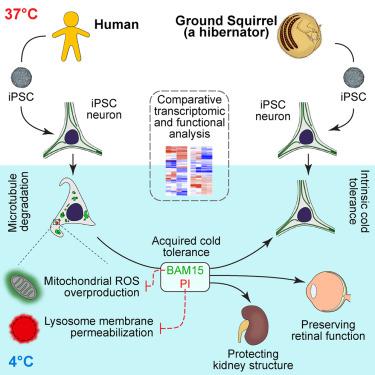Our official English website, www.x-mol.net, welcomes your
feedback! (Note: you will need to create a separate account there.)
iPSCs from a Hibernator Provide a Platform for Studying Cold Adaptation and Its Potential Medical Applications.
Cell ( IF 45.5 ) Pub Date : 2018-May-03 , DOI: 10.1016/j.cell.2018.03.010 Jingxing Ou , John M. Ball , Yizhao Luan , Tantai Zhao , Kiyoharu J. Miyagishima , Yufeng Xu , Huizhi Zhou , Jinguo Chen , Dana K. Merriman , Zhi Xie , Barbara S. Mallon , Wei Li
Cell ( IF 45.5 ) Pub Date : 2018-May-03 , DOI: 10.1016/j.cell.2018.03.010 Jingxing Ou , John M. Ball , Yizhao Luan , Tantai Zhao , Kiyoharu J. Miyagishima , Yufeng Xu , Huizhi Zhou , Jinguo Chen , Dana K. Merriman , Zhi Xie , Barbara S. Mallon , Wei Li

|
Hibernating mammals survive hypothermia (<10°C) without injury, a remarkable feat of cellular preservation that bears significance for potential medical applications. However, mechanisms imparting cold resistance, such as cytoskeleton stability, remain elusive. Using the first iPSC line from a hibernating mammal (13-lined ground squirrel), we uncovered cellular pathways critical for cold tolerance. Comparison between human and ground squirrel iPSC-derived neurons revealed differential mitochondrial and protein quality control responses to cold. In human iPSC-neurons, cold triggered mitochondrial stress, resulting in reactive oxygen species overproduction and lysosomal membrane permeabilization, contributing to microtubule destruction. Manipulations of these pathways endowed microtubule cold stability upon human iPSC-neurons and rat (a non-hibernator) retina, preserving its light responsiveness after prolonged cold exposure. Furthermore, these treatments significantly improved microtubule integrity in cold-stored kidneys, demonstrating the potential for prolonging shelf-life of organ transplants. Thus, ground squirrel iPSCs offer a unique platform for bringing cold-adaptive strategies from hibernators to humans in clinical applications. VIDEO ABSTRACT.
中文翻译:

休眠器的iPSC为研究冷适应及其潜在医学应用提供了一个平台。
冬眠的哺乳动物在体温过低(<10°C)的情况下没有受到伤害,这是细胞保存的一项壮举,对潜在的医学应用具有重要意义。然而,赋予抗寒性的机制,例如细胞骨架稳定性,仍然难以捉摸。使用来自冬眠哺乳动物的第一条iPSC品系(13根地鼠),我们发现了对耐寒性至关重要的细胞途径。人和地松鼠iPSC衍生的神经元之间的比较表明,线粒体和蛋白质对寒冷的蛋白质质量控制反应不同。在人类iPSC神经元中,冷触发线粒体应激,导致活性氧过度产生和溶酶体膜通透化,从而导致微管破坏。这些途径的操纵赋予了人类iPSC神经元和大鼠(非冬眠者)视网膜微管冷稳定性,长时间的冷暴露后仍能保持其光响应性。此外,这些治疗显着改善了冷藏肾脏中的微管完整性,证明了延长器官移植物保质期的潜力。因此,地松鼠iPSC提供了一个独特的平台,用于在临床应用中将冷适应策略从冬眠者引入人类。视频摘要。地松鼠iPSC提供了一个独特的平台,可在临床应用中将冬眠者的冷适应策略引入人类。视频摘要。地松鼠iPSC提供了一个独特的平台,可在临床应用中将冬眠者的冷适应策略引入人类。视频摘要。
更新日期:2018-04-26
中文翻译:

休眠器的iPSC为研究冷适应及其潜在医学应用提供了一个平台。
冬眠的哺乳动物在体温过低(<10°C)的情况下没有受到伤害,这是细胞保存的一项壮举,对潜在的医学应用具有重要意义。然而,赋予抗寒性的机制,例如细胞骨架稳定性,仍然难以捉摸。使用来自冬眠哺乳动物的第一条iPSC品系(13根地鼠),我们发现了对耐寒性至关重要的细胞途径。人和地松鼠iPSC衍生的神经元之间的比较表明,线粒体和蛋白质对寒冷的蛋白质质量控制反应不同。在人类iPSC神经元中,冷触发线粒体应激,导致活性氧过度产生和溶酶体膜通透化,从而导致微管破坏。这些途径的操纵赋予了人类iPSC神经元和大鼠(非冬眠者)视网膜微管冷稳定性,长时间的冷暴露后仍能保持其光响应性。此外,这些治疗显着改善了冷藏肾脏中的微管完整性,证明了延长器官移植物保质期的潜力。因此,地松鼠iPSC提供了一个独特的平台,用于在临床应用中将冷适应策略从冬眠者引入人类。视频摘要。地松鼠iPSC提供了一个独特的平台,可在临床应用中将冬眠者的冷适应策略引入人类。视频摘要。地松鼠iPSC提供了一个独特的平台,可在临床应用中将冬眠者的冷适应策略引入人类。视频摘要。









































 京公网安备 11010802027423号
京公网安备 11010802027423号